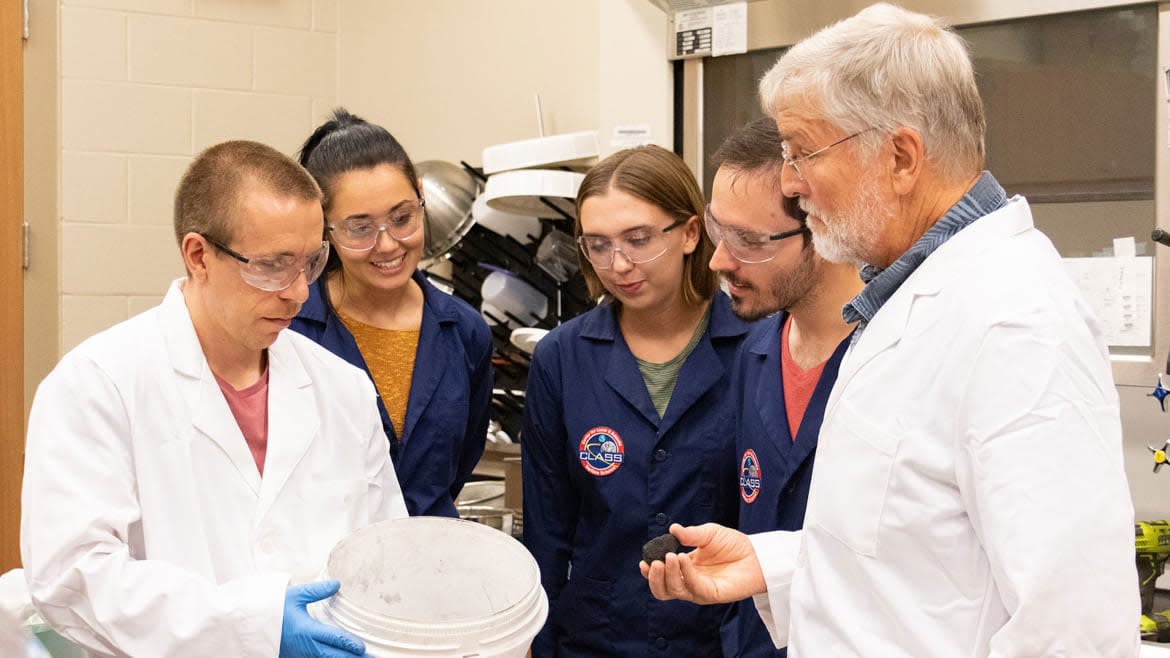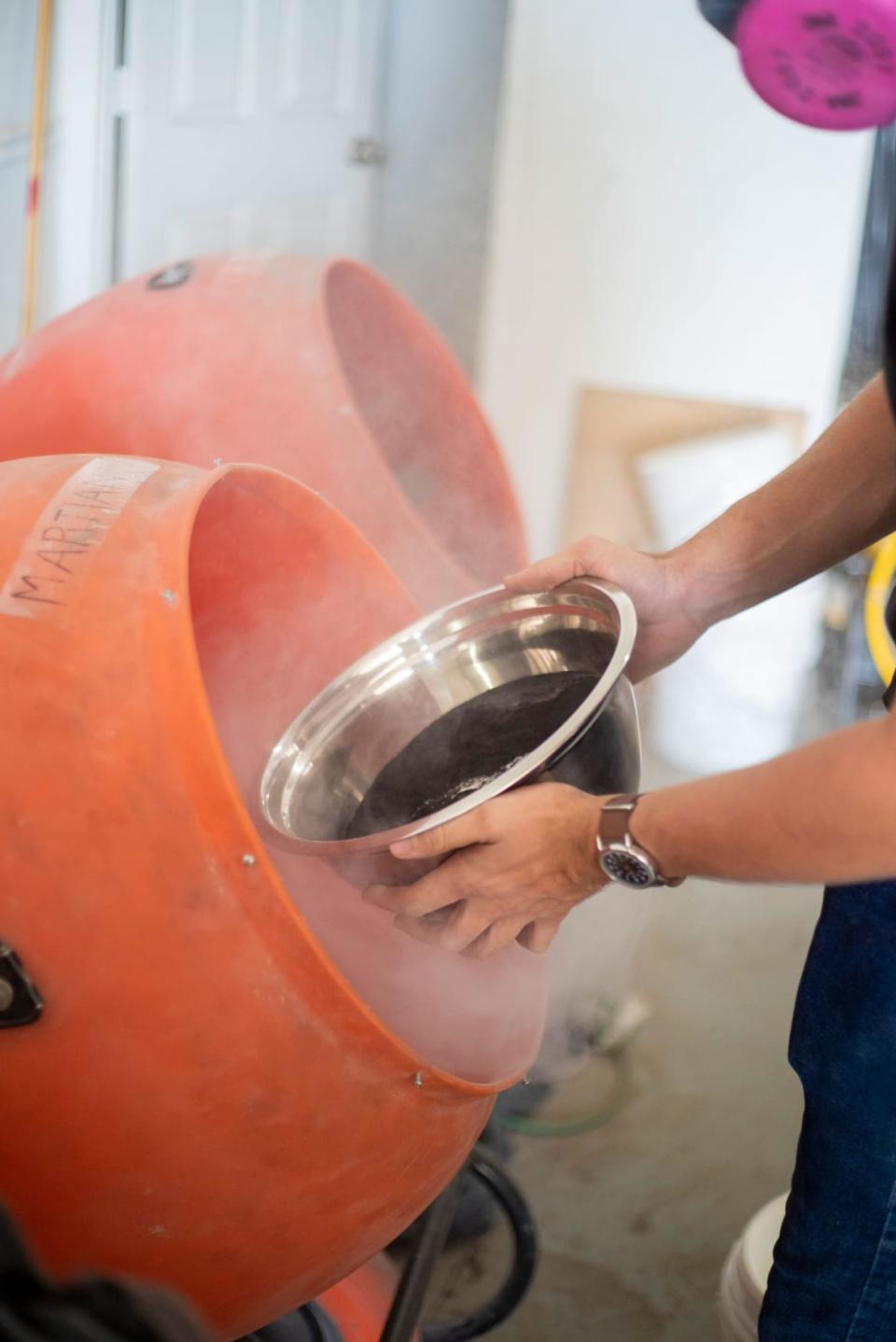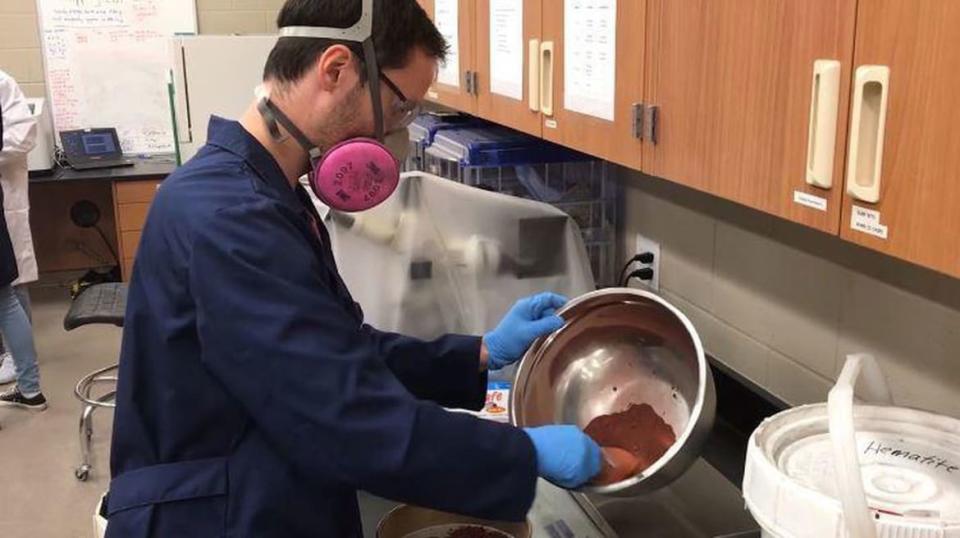The Business of Fake Martian Dirt Is Blasting Off

If humans have any hope of prolonged survival on another world, it will depend on the extraterrestrial ground beneath their boots. Thanks to the exorbitant cost of shipping goods and materials through spacecraft, astronauts must capitalize on what they find. On Mars, this means rocks, dust, and little else.
Researchers have dreamed up dozens of uses for Martian dirt, including as soil for planting, cement for landing pads, and, possibly, coagulants for deadly bleeding. There’s a hitch, though: There’s no Mars dirt on our planet. Absolutely none. Instead, Earth minerals must simulate Martian stuff. A cottage industry for this faux-alien matter has bloomed, offering soils tailored to resemble those found on other planets, asteroids, and the moon.
About 30 different Martian simulants have been developed according to one recent review study by materials scientists, making up for Earth’s complete lack of Mars dirt. Two U.S. purveyors are among the top sources: The Martian Garden in Austin and University of Central Florida’s Exolith Lab. NASA’s Extraterrestrial Materials Simulation Laboratory, at the Jet Propulsion Laboratory in California, also makes soil simulants and rock analogues for in-house use. So do some private spaceflight companies.
Inside the Fight to Save Mars From Inheriting Earth’s Mess
“Demand has been going up steadily,” planetary scientist and Exolith Lab founder Daniel Britt told The Daily Beast. The lab, which began formulating simulants in 2015, now has more than 1,000 customers. Some may buy just a few dozen pounds of the stuff. Others have picked up 10 tons of simulant in shipping containers. Exolith Lab supplied 80 times the amount of soil in 2021 than it did in 2018.
Of course, not just any dirt will do. “The bottom line here is that when you’re going to be operating in alien environments, they’re alien,” Britt said. Earth has abundant oxygen, active tectonics, liquid water and living things that warp or corrode soil in ways that don’t occur on Mars or the moon.
It requires curation, and often pulverization, to become a good stand-in for Mars soil. Rocks and minerals may be cooked to remove organic features, crushed into powder, blended, moistened, and dried out, before the simulant can be a useful research tool.
Fake Mars dirt has been mixed with human blood protein into a brick-like composite. It has been spiked with nitrogen-fixing germs to coax plants to grow. It has been sintered to create clay, then spun into a bowl on a potter’s wheel.

Christian Kastrup, who studies how blood clots at the University of British Columbia, hypothesizes that sterilized Mars soil might be used akin to gauze, plugging up bad wounds. A few years ago, Kastrup and his colleagues discovered that human blood plasma reacts with a mineral in Earth soil, triggering clotting.
“We believe our blood naturally responds to silicates that are in soil,” Kastrup told The Daily Beast. He couldn’t say yet what his lab has found using Mars simulants—the experiments are underway—but Mars, it turns out, has those same silicates. The goal is a dressing, which astronauts might not have had space to pack, for injuries “much larger than what you’d use a Band-Aid for,” Kastrup said.
Using Earth-bound dirt as a cosmic substitute is a practice that dates back to preparations for the Apollo missions. Various rocks were crushed into powders to predict what the early astronauts might encounter. Moon simulants are still used, too, because the real stuff is so precious. Apollo astronauts collected 842 pounds of lunar rocks, sand and dust. NASA doles that stuff out by the milligram.
The first generation of Mars soil simulants was created in the 1990s. Johnson Space Center’s Mars-1 was orange soil from a Hawaiian volcano. The color was right, but the contents were lacking. “It wasn’t a great match to the stuff that’s actually on the surface,” Colorado School of Mines geology professor Kevin Cannon, who helped develop Exolith Lab’s Mars simulant while at UCF, told The Daily Beast

About a decade after Mars-1’s debut, Greg Peters, then at the Extraterrestrial Materials Simulation Laboratory, and his colleagues created the Mojave Mars simulant. In California’s Mojave Desert rises Saddleback Mountain, redder than the surrounding landscape. Peters knew the place well—it was near a borax mine where his father had worked for decades.
Samples he gathered from the butte were promising. “It turns out, it’s a fair chemical match” to Mars, Peters, a technology manager at NASA’s Armstrong Flight Research Center in California, told The Daily Beast. The simulant was well received—NASA had about 10 tons of the stuff, and the paper describing the simulant has been cited more than 100 times.
It also inspired two Austin park rangers to develop their own faux-Martian dirt. In the mid-2010s, the pair, both space fans, launched a Kickstarter offering planters full of the Mojave soil. The Martian Garden was born. The company has since developed an “in-house blend” made by combining the Mojave Mars basalt with iron oxide, Mark Cusimano, one of the former rangers and Martian Garden’s chief technology officer told The Daily Beast.
Martian Garden has supplied classrooms, NASA, private companies, and universities, Cusimano said, at a few pounds to 10,000 pounds an order.
In Florida, meanwhile, Cannon and Britt created their simulant from scratch, based on Mars surface data collected by NASA’s Curiosity rover. The rover was equipped with an X-ray diffractometer, the first robot to have such an instrument on another planet. “It very nicely tells you all of the minerals that are present in the sample and in what proportions,” said Cannon.
Exolith Lab’s Mars Global Simulant draws from sources across the planet. It has acquired rock from natural structures in Idaho and Greenland, as well as commercially available minerals, such as iron ores meant for making ceramics.
“Some of these minerals are pretty tough to get,” said Cannon, who now makes bespoke simulants for Kastrup and other clients. He has sourced a mineral called plagioclase, making up 40 percent to 50 percent of Mars rocks and soil, from waste at the Stillwater platinum mine in Montana.
Once collected, the minerals are crushed and mixed. At first, Exolith Lab’s undergraduates used sledgehammers to smash rocks to size. The lab has since subbed out the undergrads for industrial mills originally made for mining, which pulverize minerals between steel plates. Mars soil shouldn’t feel like beach sand, Britt said—the product is more jagged, without the benefit of waves to wash away the sharp points.

The result is a cocktail of rocks with names like anhydrite, ferrihydrite, hematite, magnetite, olivine, plagioclase and pyroxene. It’s not a perfect mineral match to Mars. “You can introduce more minor chemicals that are present in the soil,” Cannon said, but “it's all a trade-off between the scale, the cost and the accuracy.”
In fact, perfection could be dangerous. Exact replicas of some asteroids, for example, would be illegal to market in states like California due to the space rocks’ high concentrations of carcinogenic chemicals. “We try not to kill our customers,” Britt said. Handling the material Exolith Lab provides, he added, is about as safe as sitting on beach sand.
One day, it will no longer be true that our planet lacks Martian dirt. NASA’s Perseverance rover, which landed on Mars in 2020, is equipped with what Peters called “the most complex mechanism that’s ever been set to another planet”: a 7-foot-long drill-tipped arm, which will gather samples of Mars to be sealed in tubes. If all goes well, another robotic mission will retrieve those samples and return them to Earth in the 2030s.
“When that sample return happens, that’s going to be a big game-changer,” Cusimano said. With the genuine article in hand, scientists will perform the deepest probe yet into the contents of Mars dirt, wringing fine details from the alien matter. Earth’s mineral mimics should only get better.
Get the Daily Beast's biggest scoops and scandals delivered right to your inbox. Sign up now.
Stay informed and gain unlimited access to the Daily Beast's unmatched reporting. Subscribe now.

